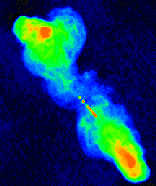
Relativistic particles: energization and radiation
Synchrotron radiation from relativistic electrons (and positrons),
spiraling in magnetic fields, provides the only way that we can see
many astrophysical objects. This is particularly true of
extragalactic radio sources. The energetics of the radiation process,
however, are not yet understood; simple application of current models
runs into problems. The radio-loud plasma is ejected from
an active galactic nucleus, and transported out to fill the radio
source. If the electrons are energized in the galactic nucleus, they
should radiate away their energy
long before they have been able to propagate throughout the sources.
Thus, we shouldn't see the sources as we do. How can this be understood?
There are two possible solutions; I am currently working on both.
One possibility is that the magnetic field is very inhomogeneous,
being localized in filaments within the source. This slows down the
radiative loss rate, compared to the well-mixed case. Another
possibility is that the electrons are locally re-energized, for
instance by plasma turbulence within the source that turns the bulk
flow energy into radiation.
Some of this work is in collaboration with:
- D.B. Melrose and M.A. Walker (RCfTA)
References: - Fluid flow and spectral aging in tailed radio galaxies
- Synchrotron aging in filamented Magnetic fields
- Where have all the old radio sources gone?

Research
Publications